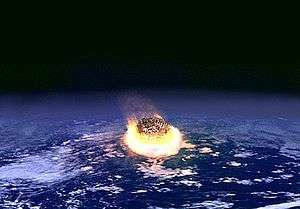1972 Great Daylight Fireball
| Date | August 10, 1972 |
|---|---|
| Location | United States, Canada |
| Images | |
|---|---|
|
The Great Daylight Fireball of 1972 (Credit & Copyright: Antarctic search for meteorites program, Case Western Reserve University, James M. Baker)[1] | |
| Video | |
|
|
The Great Daylight Fireball (or US19720810) was an Earth-grazing fireball that in 1972 passed within 57 kilometres (35 mi; 187,000 ft) of Earth's surface at 20:29 UTC on August 10, 1972. It entered Earth's atmosphere at a speed of 15 kilometres per second (9.3 mi/s)[2] in daylight over Utah, United States (14:30 local time) and passed northwards leaving the atmosphere over Alberta, Canada. It was seen by many people and recorded on film and by space-borne sensors.[3] An eyewitness to the event, located in Missoula, Montana, saw the object pass directly overhead and heard a double sonic boom. The smoke trail lingered in the atmosphere for several minutes.
The atmospheric pass modified the object's mass and orbit around the Sun, but it is probably still in an Earth-crossing orbit and passed close to Earth again in August 1997.[3] IAU's website states that these "suggestions have not been substantiated".[4]
Description
Analysis of its appearance and trajectory showed the object was about 3–14 m (10–45 ft) in diameter, depending on whether it was a comet made of ices, or a stony and therefore denser asteroid.[2][5] Other sources identified it as an Apollo asteroid in an Earth-crossing orbit that would make a subsequent close approach to Earth in August 1997.[3] In 1994, Czech astronomer Zdeněk Ceplecha reanalysed the data and suggested the passage would have reduced the asteroid's mass to about a third or half of its original mass (reducing its diameter to 2–10 metres (6.6–32.8 ft).)[5]
The object was tracked by military surveillance systems and sufficient data obtained to determine its orbit both before and after its 100-second passage through Earth's atmosphere. Its velocity was reduced by about 800 metres per second (2,600 ft/s) and the encounter significantly changed its orbital inclination from 15 degrees to 7 degrees.[2]
In popular culture
The US19720810 meteoroid is described in the preface of the first chapter of Arthur C. Clarke's The Hammer of God.
The clip featuring the fireball is shown in the 1994 made-for-TV film Without Warning, in which it is described as a 500-metre asteroid narrowly missing the Earth by thousands of feet.
See also
- 2008 TC3
- Bolide
- Earth-grazing fireball
- Earth-grazing meteoroid of 13 October 1990
- List of asteroid close approaches to Earth
- Meteor procession
Bibliography
- Abe, S.; Borovicka, J.; Spurny, P.; Koten, P.; Ceplecha, Z.; Tamagawa, T (18–22 September 2006). "Earth-grazing fireball on March 29, 2006" (abstract). Berlin: European Planetary Science Congress 2006: 486. Bibcode:2006epsc.conf..486A.
the first and second Earth-grazing fireballs observed on August 10, 1972 (Jacchia, 1974; Ceplecha, 1979) and on October 13, 1990 (Borovicka and Ceplecha, 1992)
- Abe, Shinsuke; et al. (2006). "Earth-grazing fireball on March 29, 2006" (PDF). Retrieved 2008-07-07.
full details: orbit, charts, spectra, composition
References
- ↑ Astronomy Picture of the Day. 2009 March 2.
- 1 2 3 US19720810 (Daylight Earth grazer) Global Superbolic Network Archive, 2000, 'Size: 5 to 10 m'
- 1 2 3 Observation of Meteoroid Impacts by Space-Based Sensors Astronomical Society of the Pacific, Edward Tagliaferri, 2003, 'It was first detected by satellite at an altitude of about 73 km, tracked as it descended to about 53 km, and then tracked as it climbed back out of the atmosphere', 'object is still in an Earth-crossing orbit around the Sun and passed close to the Earth again in August 1997'
- ↑ "Near Earth Asteroids (NEAs)". IAU–International Astronomical Union. Retrieved 23 August 2015.
Great Daylight 1972 Fireball (US19720810), Earth-grazing asteroid. Suggestions that this object is still in an Earth crossing orbit around the Sun and passed close to the Earth again in August 1997 have not been substantiated (Spahr, 2010, private communication).
- 1 2 Daylight Fireball of August 10, 1972 C. Kronberg, Munich Astro Archive, archived summary by Gary W. Kronk of early analysis and of Zdeněk Ceplecha's paper for Astronomy and Astrophysics in 1994, '3 meters, if a carbonaceous chondrite, or as large as 14 meters, if composed of cometary materials', 'post-encounter ... 2 or 10 meters'
External links
- US19720810 (Daylight Earth grazer) orbital characteristics from Global Superbolide Network Archive, 2000
- fireball, meteorite, bolide, meteor, video and photo link to photos and cine film by Linda Baker
- Earthgrazer: The Great Daylight Fireball of 1972 overview of the event including photo by NASA's Astronomy Picture of the Day
- Astronomical Society of the Pacific: Observation of Meteoroid Impacts by Space-Based Sensors – one of several similar events; includes ground track
- Earth Impact Calculator
- 1972 Great Daylight Fireball on YouTube
- 1972 Great Daylight Fireball at the JPL Small-Body Database
